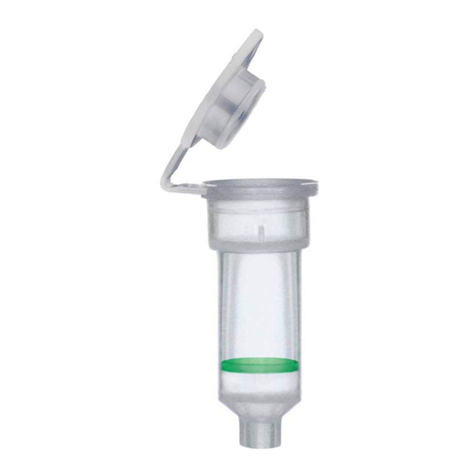
Page 8
ZYMO RESEARCH CORP.
Phone: (949
) 679
-1190 ▪ Toll Free: (888) 882-9682 ▪ Fax: (949) 266-9452 ▪ inf[email protected] ▪ www.zymoresearch.com
(C) Plant root – Lysis of surface microbes
1. Cut root into small pieces and place directly into ZR BashingBead™ Lysis Tubes (0.1 & 0.5 mm) with 750 µl of
ZymoBIOMICS™ Lysis Buffer.
2. Lysis should be performed with a lower speed bead beating device (e.g. vortex adapter for 20 minutes) to avoid the
host tissue contamination.
3. Continue to Step 3 (page 4) and proceed with the remaining protocol as written.
Water/Air Samples
1. Filter samples using desired filter (not provided) prior to Step 1 (page 4).
2. Cut the filter into small pieces and place them inside the ZR BashingBead™ Lysis Tubes (0.1 & 0.5 mm),
and add 750 µl of ZymoBIOMICS Lysis Solution.
3. Continue to Step 2 (page 4) and proceed with the remaining protocol as written.
Lytic Enzymes
Lytic enzymes, such as Lysozyme, Lysostaphin, MetaPolyzyme, etc. can be used with this kit using the following:
(A) Enzymatic lysis followed by bead beating:
1. Perform enzymatic digestion under manufacturer’s recommended conditions (temperature/time/concentration).
Note: If sample is stored in DNA/RNA Shield, perform the following:
a. Centrifuge sample at ≥ 10,000 x g for 1 minute.
b. Transfer supernatant to a ZR BashingBead Lysis Tube (0.1 & 0.5 mm), to be used in Step 2, below.
c. Re-suspend pellet in a buffer suitable for enzymatic treatment (ex. PBS or other isotonic solution).
2. Transfer the digestion mixture to a ZR BashingBead™ Lysis Tube (0.1 & 0.5 mm).
3. Add 750 µl ZymoBIOMICS™ Lysis Solution.
Note: For samples in DNA/RNA Shield, raise to a final volume of 1 ml with DNA/RNA Shield.
4. Proceed to Step 2 (page 4) and continue with the remaining protocol as written.
(B) Enzymatic lysis only (no bead beating):
1. Perform enzymatic digestion under manufacturer’s recommended conditions (temperature/time/concentration).
Note: If sample is stored in DNA/RNA Shield, perform the following:
a. Centrifuge sample at ≥ 10,000 x g for 1 minute.
b. Transfer supernatant to a clean microcentrifuge tube, to be used in Step 2.
c. Re-suspend pellet in a buffer suitable for enzymatic treatment (ex. PBS or other isotonic solution).
2. Raise the volume of sample to 400 µl with ZymoBIOMICS™ Lysis Solution.
3. Continue to Step 4 (page 4) and proceed with the remaining proceed as written.
Hair, Feather, and Nail Samples:
1. To ≤ 25 mg sample, add 90 µl Water, 90 µl Solid Tissue Buffer (Blue) (Cat. No. D4068-2-6), 10 µl 1M DTT,
and 10 µl Proteinase K (Cat. No. D3001-2-5) in a microcentrifuge tube.
2. Mix thoroughly or vortex 10-15 seconds and then incubate the tube at 55ºC overnight.
3. Transfer lysate to a ZR BashingBead™ Lysis Tube (0.1 & 0.5 mm) and then add 750 µl ZymoBIOMICS™
Lysis Solution.
4. Continue to Step 2 (page 4) and proceed with the remaining protocol as written.




























